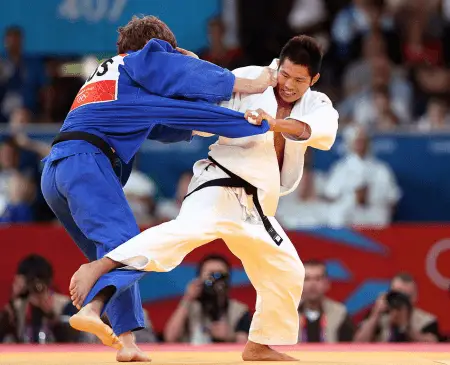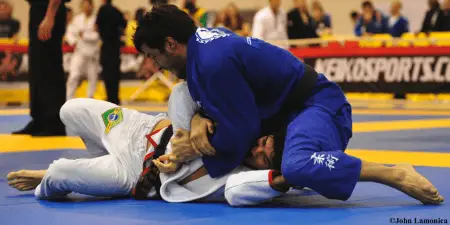Are you interested in taking up a sport? A contact sport maybe? What do you say about Judo? Or is Jiu-Jitsu more your style? And there is always Brazilian Jiu-Jitsu to take into consideration. If these questions got you confused and you would not know which of these sports to choose, you’d better read this article. You will discover the differences between Judo, Jiu-Jitsu, and Brazilian Jiu-Jitsu.
Summary Table
| Judo | Jiu-Jitsu | Brazilian Jiu-Jitsu |
| Developed in 1882 | Created in Feudal Japan | The first school opened in Brazil in 1925 |
| Founded by Jigoro Kano, the President of the University of Education in Tokyo | Was practiced by the Samurai | Was developed by Helio and Carlos Gracie and Luiz Franca |
| Developed in Japan | Developed in Japan | Developed in Brazil |
| Is a sport and a philosophy of life | Is a combat technique | Is a Sport and a combat technique |
| Also known as “The Gentle Way,” provides a different approach to combat techniques | Was developed as a means of gaining an advantage on the battle field against an armed opponent | Meant to give people of a smaller built an advantage when fighting a bigger opponent |
| Throws and basic control techniques are important | Is somewhat more violent | Focuses on sparring and controlling your opponent on the ground |
| Looser gis to allow opponents an easier grab | Tight gis to prevent opponents from grabbing with ease | Reinforced gis to keep the uniform on during sparring |
Descriptions

Judo is a sport developed in 1882 in Japan by Dr. Jigoro Kano, President of the University of Education in Tokyo. In 1964, it became the first martial art to be included in the Olympic Sports. In translation, Judo means “The Gentle Way.” The technique is an adaptation of the ancient Jiu-Jitsu practices.
Judo mainly consists of developing techniques of throwing your opponent on the floor and ways of controlling him on the ground. This implies grabbing your opponent, making him go off-balance, then keeping him in a chokehold, pinned to the ground. Once pinned to the floor, the opponent should surrender or he risks dislocating his shoulder from an armlock or fainting from the chokehold. As a sport, points are awarded for throws and for controlling the opponent while down. A Judokan can win a match with a perfect throw or two nearly perfect throws and 25 seconds of holding the opponent on this back, plus other variations.
The Judo philosophy consists of using a minimum amount of strength required to put the opponent down. This implies mastering the Judo techniques and proper timing. A person practicing Judo is called a Judokan. Training sessions are held by martial art instructors and everybody wears a uniform. A characteristic of Judo is that the gi (Judogi – the uniform) is a bit loose around the body. This gives opponents a chance at a good grab.
Among the many reasons why people practice Judo, a few are the possibility of learning self-defense techniques, getting a great exercise, socializing, and even learning how to apply the Judo philosophy to other aspects of life.

Jiu-Jitsu is a Japanese martial art and a combat technique meant to help someone tackle an armed opponent while unarmed or armed with a very small weapon. It dates back to Feudal Japan and it was developed by the Samurai. The idea behind Jiu-Jitsu is to manipulate the opponent’s force against him.
Traditionally, since Jiu-Jitsu was developed as a combat technique which was used on the battlefield, it also included nerve and vital organ attacks. Apart from the general notions of throwing the opponent to the ground and pinning him down, some techniques used in variations of Jiu-Jitsu are joint locks, holds, stricking and kicking, biting, and gouging. Some schools even allow the use of weapons. The type of Jiu-Jitsu you practice depends on the school you attend.
Training sessions are conducted by a Jiu-Jitsu instructor in a special facility. All participants need to wear uniforms that are tight around the body, making it difficult for the opponent to grab and throw.

Brazilian Jiu-Jitsu is an offspring of Judo. This is a combat sport practiced worldwide, with a focus on grappling and ground fighting. Carlos and Helio Gracie and Luiz Franca were the ones who turned Brazilian Jiu-Jitsu into a sport of its own. They perfected the style and teachings of Esai Maeda, the chief of a Japanese immigration colony assigned to Brazil. Many people who practice it enjoy the physical training and the fact that it helps build character.
The sport is mainly built around ground fighting fundamentals and it is an adaptation of Jiu-Jitsu techniques to be used by people of a smaller build. The focus lies with gaining the superior position, then applying chokes, locks, and holds. There is no striking in Jiu-Jitsu. Since there is a lot of sparring in this sport, the gis (uniforms) are reinforced to withstand the rigorous training sessions.
Judo vs Jiu-Jitsu vs Brazilian Jiu-Jitsu
So what is the difference between Judo, Jiu-Jitsu and Brazilian Jiu-Jitsu?
To understand the differences between them, it is best to first understand what connects them. They stemmed one from another. First, there was Jiu-Jitsu, developed in Feudal Japan as a combat technique used by the Samurai. Judo was developed in the 19th century as a technique that later turned into a sport. Brazilian Jiu-Jistu stemmed from both of them because with the promotion of Judo as a sport, people became aware of the principles of its precursor, Jiu-Jitsu. The first Brazilian Jiu-Jitsu school opened in 1925.
They also differ in essence. Judo was a sport and a life philosophy, Jiu-Jitsu was a form of combat, and Brazilian Jiu-Jitsu combines the two (both the combat technique as well as the sport).
Jiu-Jitsu was developed as a means of gaining an advantage on the battle field against an armed opponent. The techniques practiced in Jiu-Jitsu may include tricking your opponent, biting, gouging, striking, and kicking. In its original form, it included nerve and organ attacks. Judo was developed by giving a gentler approach to the Jiu-Jitsu techniques. Brazilian Jiu-Jitsu was coined to fit the style of smaller people when fighting bigger opponents.





